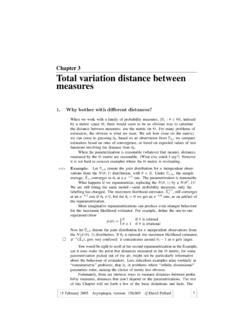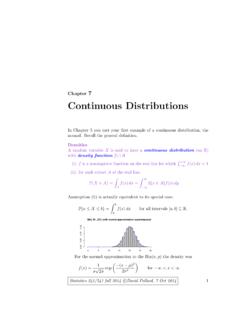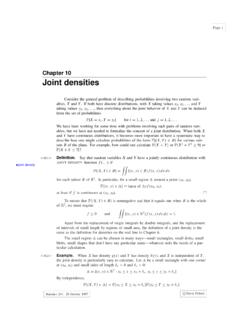Transcription of The bigmemory Package: Handling Large Data Sets in R …
1 JSS Journal of Statistical Software MMMMMM YYYY, Volume VV, Issue II. The R Package bigmemory : Supporting Efficient Computation and Concurrent Programming with Large Data Sets. John W. Emerson Michael J. Kane Yale University Yale University Abstract Multi-gigabyte data sets challenge and frustrate R users even on well-equipped hard- ware. C/C++ and Fortran programming can be helpful, but is cumbersome for interactive data analysis and lacks the flexibility and power of R's rich statistical programming envi- ronment. The new package bigmemory bridges this gap, implementing massive matrices in memory (managed in R but implemented in C++) and supporting their basic manipu- lation and exploration.
2 It is ideal for problems involving the analysis in R of manageable subsets of the data, or when an analysis is conducted mostly in C++. In a Unix envi- ronment, the data structure may be allocated to shared memory with transparent read and write locking, allowing separate processes on the same computer to share access to a single copy of the data set. This opens the door for more powerful parallel analyses and data mining of massive data sets. Keywords: memory, data, statistics, C++, shared memory. 1. Introduction A numeric matrix containing 100 million rows and 5 columns consumes approximately 4.
3 Gigabytes (GB) of memory in the R statistical programming environment (R Development Core Team 2008). Such massive, multi-gigabyte data sets challenge and frustrate R users even on well-equipped hardware. Even moderately Large data sets can be problematic; guidelines on R's native capabilities are discussed in the installation manual (R Development Core Team 2007). C/C++ or Fortran allow quick, memory-efficient operations on massive data sets, without the memory overhead of many R operations. Unfortunately, these languages are not well-suited for interactive data exploration, lacking the flexibility, power, and convenience of R's rich environment.
4 2 The bigmemory Package The new package bigmemory bridges the gap between R and C++, implementing massive matrices in memory and supporting their basic manipulation and exploration. Version supports matrices of double, integer, short, and char data types. In Unix environments, the package supports the use of shared memory for matrices with transparent read and write locking (mutual exclusions). An API is also provided, allowing savvy C++ programmers to extend the functionality of bigmemory . As of 2008, typical high-end personal computers (PCs) have 1-4 GB of random access memory (RAM) and some still run 32-bit operating systems.
5 A small number of PCs might have more than 4 GB of memory and 64-bit operating systems, and such configurations are now common on workstations, servers and high-performance computing clusters. At Google, for example, Daryl Pregibon's group uses 64-bit Linux workstations with up to 32 GB of RAM. His group studies massive subsets of terabytes (though perhaps not googols) of data. Massive data sets are increasingly common; the Netflix Prize competition (Netflix, Inc. 2006) involves the analysis of approximately 100 million movie ratings, and the basic data structure would be a 100 million by 5 matrix of integers (movie ID, customer ID, rating, rental year and month).
6 Data frames and matrices in R were designed for data sets much smaller in size than the computer's memory limit. They are flexible and easy to use, with typical manipulations executing quickly on smaller data sets. They suit the needs of the vast majority of R users and work seamlessly with existing R functions and packages . Problems arise, however, with larger data sets; we provide a brief discussion in the appendix. A second category of data sets are those requiring more memory than a machine's RAM. CRAN and Bioconductor packages such as DBI, RJDBC, RMySQL, RODBC, ROracle, TSMySQL, filehashSQLite, TSSQLite, pgUtils, and Rdbi allow users to extract subsets of tra- ditional databases using SQL statements.
7 Other packages , such as filehash, , Buffered- Matrix, and ff, provide a convenient interface to data stored in files. The authors of the ff package (Adler, Nenadic, Zucchini, and Glaeser 2007) note that the idea is that one can read from and write to flat files, and operate on the parts that have been loaded into R. While each of these tools help manage massive data sets, the user is often forced to wait for disk accesses, and none of these are well-suited to Handling the synchronization challenges posed by concurrent programming. The bigmemory package addresses a third category of data sets.
8 These can be massive data sets (perhaps requiring several GB of memory on typical computers, as of 2008) but not larger than the total available RAM. In this case, disk accesses are unnecessary. In some cases, a traditional data frame or matrix might suffice to store the data, but there may not be enough RAM to handle the overhead of working with a data frame or matrix. The appendix outlines some of R's limitations for this type of data set. The class has been created to fill this niche, creating efficiencies with respect to data types and opportunities for parallel computing and analyses of massive data sets in RAM using R.
9 Fast-forward to year 2016, eight years hence. A naive application of Moore's Law projects a sixteen-fold increase (four doublings) in hardware capacity, although experts caution that the free lunch is over (Sutter 2005). They predict that further boosts in CPU performance will be limited, and note that manufacturers are turning to hyper-threading and multicore archi- tectures, renewing interest in parallel computing. We designed bigmemory for the purpose of fully exploiting available RAM for Large data analysis problems, and to facilitate concurrent programming.
10 Journal of Statistical Software 3. Multiple processors on the same machine can share access to the same copy of the massive data set, and subsets of rows and columns may be extracted quickly and easily for standard analyses in R. Transparent read and write locks provide protection from well-known pitfalls of parallel programming. Most significantly, R users of bigmemory don't need to be C++. experts (and don't have to use C++ at all, in most cases). And C++ programmers can make use of R as a convenient interface, without needing to become experts in the environment.












